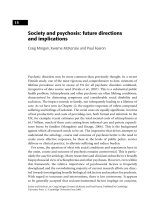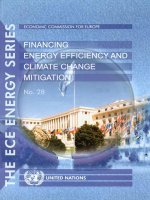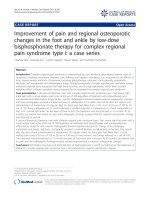Future global and regional climate change
Bạn đang xem bản rút gọn của tài liệu. Xem và tải ngay bản đầy đủ của tài liệu tại đây (839.29 KB, 12 trang )
Future Global and
Regional Climate
Change
E. Future global and regional
climate change
1.
Atmosphere: Temperature
2.
Atmosphere: Water Cycle
3.
Air quality
4.
Ocean
5.
Cryosphere
6.
Sea level
7.
Carbon and other Biogeochemical Cycles
8.
Climate stabilization, Climate change commitment and
Irreversibility
RCP: Representative Concentration
Pathways
• Models used to predict what will happen in the future
• using RCP’s (Representative Concentration Pathways) to
show alternative future scenarios
• 4 different RCP’s (scenarios)
E1: Temperature
• Increased temperatures
• Mean increase between 0.3 - 0.7 ºC
• Heat waves
• More frequent
• Longer duration
• Regionalized
• Temperature change will influence the tropical and sub tropical regions more than midlatitude locations
• Temperature rises will be more dramatic over land mass than the sea
- Negative effect on the Artic
E2: Water cycle
• Cycles
• Changes in the global water cycles, caused by global warming, will not be uniform
• Precipitation (rainfall or snowfall) levels
• Some regions will experience a decrease in precipitation
• The annual precipitation in Pacific Ocean will increase
• Precipitation events
• Monsoon strengths will intensify due to the increase in atmospheric moisture
• Extreme precipitation events will be more intense and more frequent
• There will be more of a contrast in seasons causing extreme floods and droughts
E3: Air quality
• Conclusions drawn predict that air quality will be determined more so by the level of
pollutants and emissions rather than by physical climate change.
• Globally
• The physical affect that physical climate change does have on air quality is concerned with the
ozone layer
• The global temperature alters the background surface of the ozone layer, and weakens it
• Regionally
• Poor air quality will be much more of a localised phenomenom
• Locally higher surface temperatures in polluted regions will trigger regional feedbacks in
chemistry and local emissions which will increase peak levels of zone an PM 2.5
Hanoi vs Wellington (nz)
E4: Ocean
• Temperature
• Predictions indicate that the global sea temperature will continue to warm
•
•
Where?
•
The ocean can warm at different depths, in different regions creating different outcomes
•
Surface heating will be concentrated in the tropical and NORTHERN HEMISPHERE sub-tropical
regions
•
Deep ocean heating will occur more intensely in the Southern Hemisphere
Effects
•
When the ocean temperature changes it also changes the strengths of the ocean currents
•
The currents in the Atlantic ocean are predicted to weaken the most
E5: Cryosphere
• Cryosphere - snow, ice sheets, glaciers
• The ArCtic sea ice COVER will decrease
• The North Hemisphere spring snow COVER will DEcreasE
• The global glacier VOLUME will FURTHER DECREASE
• By the end of the 21st century glacier levels have been
predicted to decrease by 15% - 85%
E6: Sea Levels
• Trend:
• Sea levels WILL rise
• Why:
• Ice sheet melt AND OCEAN WARMING
• Increased and changing precipitation levels
• Prediction
• Sea level rises between 26cm – 82cm
• Sea levels will rise in 95% of the OCEAN AREA
• sea level RISE will not be uniform
• E.g 70% of the world are projected to experience change within 20% of the global average
E7: Carbon and Biogeochemical
cycles
- Climate change will effect the way that the carbon cycle
processes work
- This will result in an increase of Co2 in the atmosphere
- The increase in Carbon into the atmosphere will in turn
increase acidification levels in the ocean
E8: Climate stabilization, Climate change
commitment and Irreversibility
• Most aspects of climate change will persist for many centuries, even if the
Co2 emissions are stopped
• These affects are irreversible exCePt in the case of a large net removal of
CO2 from the atmosphere over a sustained period.
• What the future has to contend with:
• About 15 to 40% of emitted CO2 will remain in the atmosphere longer than
1,000 years
• Over a millennium or more, sustained warming would lead to the near-complete
loss of the Greenland ice sheet causing a global mean sea level rise of up to 7 m









